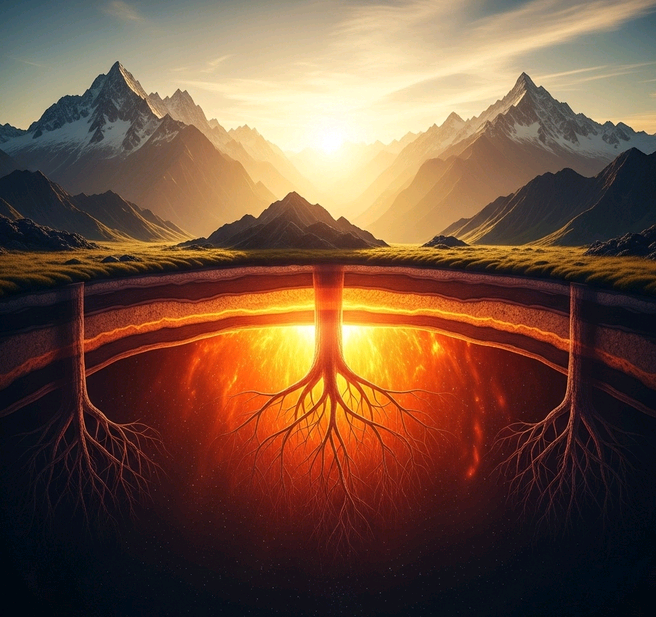
How Deep Are Mountain Roots? Unveiling Earth’s Hidden Foundations
Regional SpecificsBeneath the Peaks: How far down is the crust of the Earth under mountains?
The magnificent grandeur of soaring mountain ranges—their craggy peaks brushing the heavens—always astounds us. But have you ever pondered what is upholding these enormous structures? It is far more than just a superficial aspect; deep within our world sits a concealed, huge root beneath every mountain. Being an outdoors enthusiast and a geologist, I am quite enthralled by this hidden architecture of the Earth. Let’s investigate the foundation of the highest mountains on Earth.
A Varied Crust: The Skin of the Earth
Let’s first briefly review the outermost layer of Earth: the crust. Like the skin of an apple next to the fruit itself, it is shockingly thin. This skin, though, is not uniform.
- Oceanic Crust: Forming the ocean bottoms, the thinner, denser kind of crust known as Oceanic Crust measures just around 5 to 10 kilometers (3 to 6 miles) thick on average.
- Continental crust: Continental crust forms our landmasses. With an average of roughly 30 to 50 kilometers (19 to 31 miles), it is considerably thicker and less dense than oceanic crust.
Hidden Footings of The Mountain: Deep Crustal Roots
Mountains start their role here. Know that the real majesty of a great mountain range goes well beyond what one sees. Underneath these majestic mountains, the continental crust thickens significantly to create what geologists refer to as a mountain root.
Picture an iceberg: only a tiny section is visible above the water; the great part is submerged beneath. Mountains act similarly. A mountain range’s great weight must be supported; it does this by pushing down into the heavier material below, displacing it and producing a deep downward extension of the crust. Isostasy, in which lighter crustal material floats on the more dense mantle, helps to clarify this idea.
At astounding depths of 60 to 80 kilometers (37 to 50 miles) under the great mountain ranges of the earth—the lofty Himalayas or the towering Andes—the crust can sink. In some extraordinary instances, like the Tibetan Plateau, which supports the Himalayas, the crust can reach up to 90 kilometers (56 miles). This causes the crust under mountains to be much thicker than the average continental crust.
The Moho: The Underlying Line
Hence, what sits just below this extremely thick crust? That would be Mohorovičić’s discontinuity, or Moho. The Moho is the clear dividing line between the crust of the Earth and the much denser, iron- and magnesium-rich rock of the mantle. Scientists locate the Moho by a rapid rise in the speed of seismic waves going across Earth. The deeper the crustal base of a mountain, therefore, the lower the Moho is in that area.
Finding the depths: How We Know This
Direct measurement of the crust would require us to drill down 90 kilometers, but the deepest scientific boreholes are just approximately 12 km. Thus, how do researchers determine how thick the crust is, particularly beneath mountains?
The main approach is the analysis of seismic waves. Earthquakes and artificial seismic waves generated by researchers spread across and reflect off various strata and interfaces, including the Moho. Geophysicists can construct a complete image of the internal composition of the Earth and exactly determine the thickness of the crust by studying how quickly these waves propagate and where they reflect. Furthermore, gravitational studies—often involving satellites—offer understanding of crustal thickness since denser substances exert a greater gravitational pull.
Next time you stare at a magnificent mountain, pause to consider not just its sky-high peaks but also its hidden, enormous roots holding it deeply within our amazing world. It’s evidence of the strong and energetic forces always in operation below our feet.
You may also like
Disclaimer
Categories
- Climate & Climate Zones
- Data & Analysis
- Earth Science
- Energy & Resources
- Facts
- General Knowledge & Education
- Geology & Landform
- Hiking & Activities
- Historical Aspects
- Human Impact
- Modeling & Prediction
- Natural Environments
- Outdoor Gear
- Polar & Ice Regions
- Regional Specifics
- Review
- Safety & Hazards
- Software & Programming
- Space & Navigation
- Storage
- Water Bodies
- Weather & Forecasts
- Wildlife & Biology
New Posts
- Diving Deep into Tangerine: More Than Just a Sunny Locale
- Jamaica Backpack Daypack Pockets Shopping – Review
- TEOYETTSF Climbing Backpack Multifunction Military – Buying Guide
- The Curious Case of Cavendish’s Classroom: Where Did This Science Star Study?
- Dragon Backpack Insulated Shoulder Daypack – Buying Guide
- ROCKY Hi-Wire Western Boots: A Rugged Review After a Month on the Ranch
- Vertical Curbs: More Than Just Concrete Barriers
- Regatta Modern Mens Amble Boots – Honest Review
- YMGSCC Microfiber Leather Sandals: Beach to Boardwalk, Did They Hold Up?
- Tangier: More Than Just a Backdrop in “Tangerine”
- DJUETRUI Water Shoes: Dive In or Doggy Paddle? A Hands-On Review
- Barefoot Yellow Pattern Hiking 12women – Is It Worth Buying?
- Koa Trees: How Fast Do These Hawaiian Giants Really Grow?
- DDTKLSNV Bucket Hat: Is This Packable Sun Shield Worth the Hype?